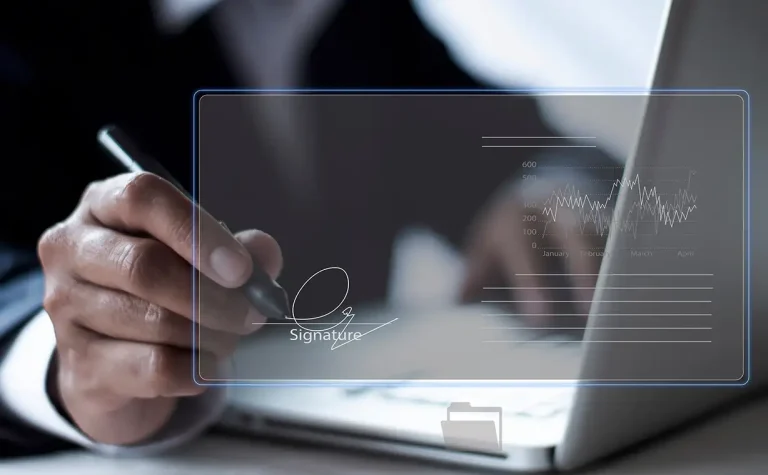What is an electronic seal and how does it help make life easier for companies that work continuously with governments and public entities? Below we dive into this very useful tool for the vast majority of companies, regardless of the sector, telling you about the existing types, their advantages and how to take advantage of it with some of our tools.
We must recognize that going to an office of any public body to resolve a formality or simply to deposit an application, claim or any other procedure in the registry is exasperating, as well as entailing a considerable loss of hours that could be invested in more productive tasks.
Fortunately, the new options offered by this increasingly digital society are helping us to make these experiences more and more a thing of the past. This is where electronic signature and authentication procedures come into play. Among them, the so-called electronic seal is essential for the Public Administration. What does it consist of and what can it be used for? We discuss it in this article.
Digital transformation in public administration
The electronic seal is part of the digitization process of the public sector that results in what is known as e-Administration or e-Administration.
To put us in the picture, we will have to take a look at the current situation of digital transformation in Spanish public institutions. For this, we will find the Digital Economy and Society Index (DESI) 2019 very useful.
As far as e-Government is concerned in this report, Spain is in a very good fourth position among the member countries of the European Union, with a rise of 4.7 points compared to the 2018 report.
It is worth noting that the percentage of e-Government users has increased from 67% to 76% and that we are in second place in terms of open data. It should also be noted that 76% of Spanish Internet users actively participate in e-Government services.
What is the electronic seal?
To begin with, the most convenient thing to do is to resort to the definition of the electronic seal and, to do so, there is nothing better than to refer to the legislative framework that contemplates it, which is made up of the following:
- EU Regulation No. 910/2014 on electronic identification and trust services for electronic transactions in the internal market, eIDAS.
- Law 39/2015 of October 1 of the Common Administrative Procedure of Public Administrations of electronic access of citizens to Public Services.
According to these normative references, 3 categories of electronic seals are defined:
- Electronic seal: data in electronic format linked to other data in electronic format, or logically associated with them, verifying their origin and integrity.
- Advanced electronic seal: this must comply with the following requirements:
- Be uniquely bonded to the sealant.
- Allow identification of the sealant.
- Have been created using electronic seal creation data that the sealer can use for the creation of an electronic seal, with a high level of confidence, under his control.
- Be linked to the data to which it refers in such a way that any subsequent modification of this data is recognizable.
- Recognized or qualified electronic seal: it meets the same requirements as the advanced electronic seal, but, in addition, it is created by means of a qualified electronic seal creation device based on a qualified electronic seal certificate. It is very similar to the previous company certificate.
As we can see, the definitions of the different types of electronic seal are very similar to those of the electronic signature, with the difference that the electronic seal allows legal entities and companies to authenticate a procedure carried out in the Administration automatically.
We can say that the electronic seal is the digital brother of the seal that was stamped on each document that we presented in a Public Administration office every time we had to carry out any procedure there.
Electronic seal is not the same as timestamp
We consider it important to emphasize that the electronic seal and the time stamp are two concepts that must be differentiated.
By time stamp we mean the electronic mechanism that ensures that an electronic signature exists from a certain time and has not been altered after its realization. So it acts as a proof of the integrity of the signature.
Technically speaking, the Public Key Infrastructure (PKI) is used for time stamping. The format in which the signature is returned is called XAdES-T.
For the creation of these time stamps, the intervention of what was called, until the arrival of eIDAS, a Time Stamping Authority or TSA, from Timestamping Authority, and now a Time Stamp Service Provider, which, as in the case of the electronic stamp, can be advanced or qualified, is required.
We will elaborate on the interesting characteristics of the time stamp in other articles, but it is important to be clear about the distinction with the electronic stamp.
The electronic seal certificate
Qualified electronic seals require the use of their own certificates in order to be applied. According to Law 40/2015 the FNMT-RCM, three types of certificates are recognized in the field of public institutions:
- Certificate of electronic signature of the personnel at the service of the Public Administration or Certificate of public employee.
- Certificate of electronic site in the scope of the Administration: they are used to identify a web portal.
- Certificate of electronic seal in the scope of the Administration.
This electronic seal certificate has, in addition to the electronic seal itself, other applications, such as:
- Authentication of an entity’s IT components to access services or infrastructures that require identification.
- Exchange of encrypted information with total security guarantees.
- Signing of electronic invoices.
Benefits of the electronic seal
With the advent of the electronic seal, companies and institutions have greatly streamlined their dealings with government agencies. For example, it is no longer necessary to spend a whole morning at work to go to a certain public office to deliver some documents, or to carry out any other operation.
The benefits of the electronic seal go beyond the use in the electronic administration, since it can be used in any commercial or internal document that needed to be sealed by the company: budgets, invoices, payrolls, etc.
Nor should we underestimate the added security provided by these authentication methods, which reduces the risk of fraud.
All of this results in greater efficiency in business tasks, reducing expenses and optimizing productivity due to the greater investment of hours in tasks that really add value to the company and not in tedious bureaucratic procedures.

All Viafirma’s solutions take advantage of the electronic seal, especially in the so-called unattended signature. The unattended signature has a huge amount of applications: online sales in which the purchase documents are automatically, securely and reliably sealed by the supplier, an act of merchandise delivery in which the document that is delivered to be signed by the client incorporates the company’s electronic seal, the massive sending of payrolls to employees with the company’s seal, etc.
In Viafirma Documents you can incorporate an electronic seal in any document, customizing the signature policies; in Viafirma Inbox you can include an electronic seal in any point of a signature flow; in Viafirma Fortress, our digital identity management and centralized signature solution, it is possible to use the electronic seal unattended through API, automating mechanical and repetitive sealing processes.
In conclusion, we can say that the electronic seal has brought about a significant change in the way private companies and government entities relate to each other, thus completing another stage in the race towards e-Government in which Spain is so well positioned.



